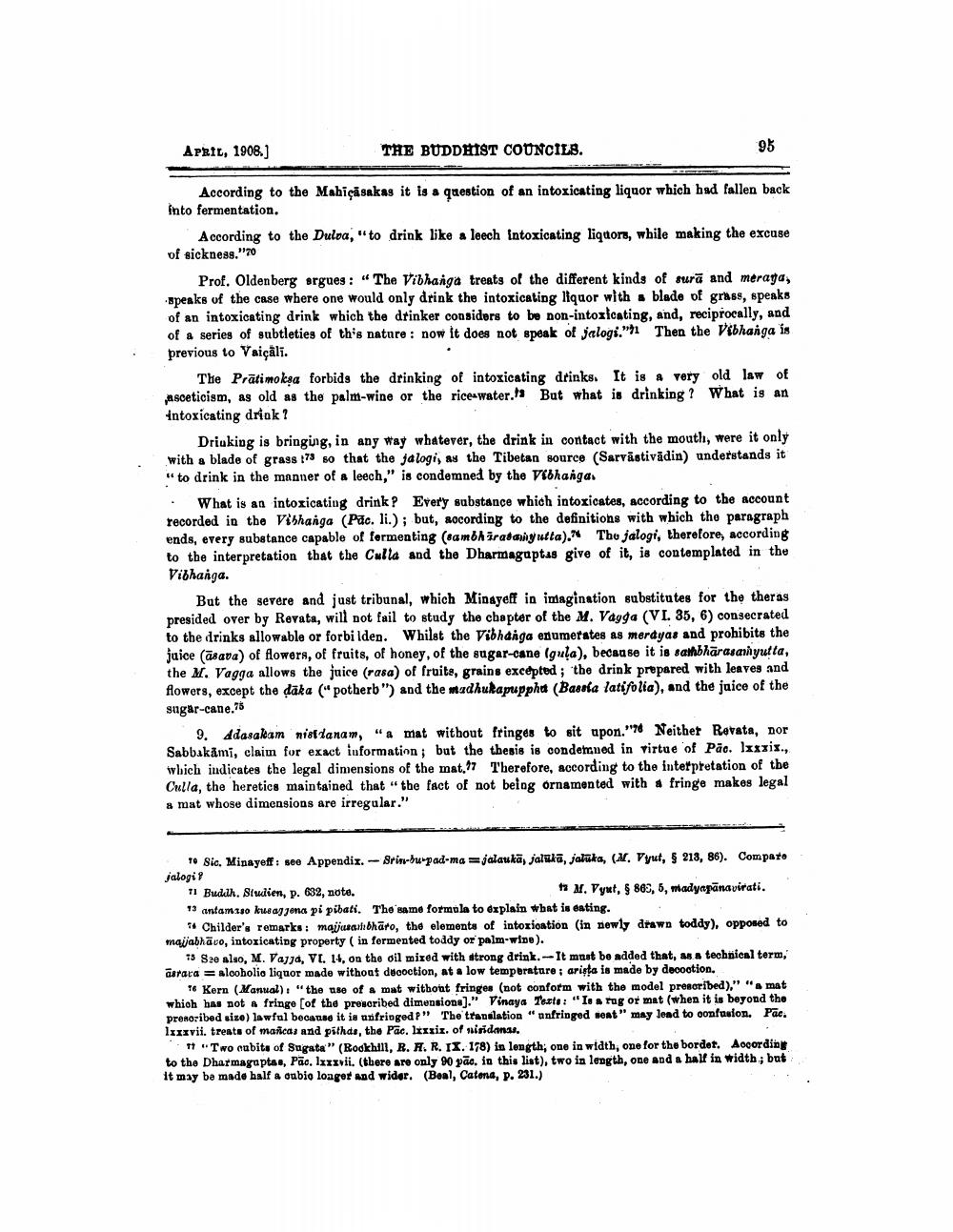________________
APRIL, 1908.)
THE BUDDHIST COUNCILS.
95
According to the Mabicāsakas it is a qaestion of an intoxicating liquor which had fallen back into fermentation.
According to the Dulpa," to drink like a leech intoxicating liquors, while making the excuse of sickness."70
Prof. Oldenberg argues : “The Vibhanga treats of the different kinds of surā and merata, -speaks of the case where one would only drink the intoxicating liquor with a blade of grass, speaks of an intoxicating drink which the dtinker considers to be non-intoxicating, and, reciprocally, and of a series of subtleties of this nature : now it does not speak of jalogi." Then the Vibhanga is previous to Vaicāli.
The Prātimoksa forbids the drinking of intoxicating drinks. It is very old law of asceticism, as old as the palm-wine or the rice water. But what is drinking? What is an intoxicating driok ?
Driuking is bringing, in any way whatever, the drink in contact with the mouth, were it only with a blade of grass 73 so that the jalogi, as the Tibetan source (Sarvästivādin) understands it
to drink in the manner of a leech," is condemned by the Vibhanga • What is an intoxicating drink P Every substance which intoxicates, according to the account recorded in the Vibhanga (Pac. li.) ; but, socording to the definitions with which tho paragraph ends, every substance capable of fermenting (sambhiratangutta). The jalogi, therefore, according to the interpretation that the Culla and the Dharmagaptas give of it, is contemplated in the Vibhanga.
But the severe and just tribunal, which Minayeft in imagination substitutes for the theras presided over by Revata, will not fail to study the chapter of the M. Vagga (VI. 35, 6) consecrated to the drinks allowable or forbi Iden. Whilst the Vibhanga enumerates as merdyas and prohibits the juice (āsava) of flowers, of fruits, of honey, of the sugar-cane (gula), because it is sathbhārasanyutta, the M. Vagga allows the juice (rasa) of fruits, grains excepted; the drink prepared with leaves and flowers, except the däka ("potherb") and the madhukapuppha (Bassia latifolia), and the juice of the sugar-cane.75
9. Adasakam nistdanam, "a mat without fringes to sit apon."76 Neithet Revata, nor Sabbakåmi, claim for exact information, but the thesis is condemned in virtue of Pão. lxxxix., which indicates the legal dimensions of the mat.97 Therefore, according to the interpretation of the Culla, the heretics maintained that the fact of not being ornamented with a fringe makes legal s mat whose dimensions are irregular."
to Sic. Minayeff: see Appendix. -Sriw-bu-pad-ma = jalaukā, jalikā, jaluka, (M. Vyut, $ 213, 86). Compato jalogi? 11 Buduh. Studien, p. 632, note.
1 M. Vyut, $ 865, 6, madyapāna virati. 13 antamiso kusaggona pi pibati. The same formula to explain what is eating.
Childer's remarks: majjuta bhāro, the elements of intoxioation (in newly drawn toddy), opposed to majjabhāco, intoxicating property (in fermented toddy or palm-wide).
15 Sze also, M. Vajja, VL. 14, on the oil mired with strong drink. - It must be added that, as a technical term, asrara = alcoholio liquor made withoat decoction, at a low temperature, arista is made by decoction.
16 Kern (Manual). "the use of a mat without fringes (not conform with the model prescribed)." "mat whioh has not a fringo [of the prescribed dimensions]." Vinaya Toulo: "Iss rug or mat (when it is beyond the prenoribed size) lawful because it is anfringedP" The translation "unfringed seat" may lead to confusion. Pac. lxxxvii. treats of malcas and pithas, the Pac. lxxxix. of saisidansi.
17 "Two cubits of Sugata" (Rockhill, R. R. R.IX. 178) in length; one in width, one for the bordet. According to the Dharmagaptae, Pão. lxxxvii. (there are only 90 pāc. in this list), two in length, one and a half in width; but It may be made half a oubio loager and wider. (Beal, Catena, p. 231.)




